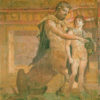The Roman strigoi and Greek maenads might have been heavily influenced by the satyr people, to the point of imagery such as the thyrsus being present. The thyrsus is an older version of the rod of Aesculapius. Aesculapius himself having been said to have been tutored by the satyr/centaur chiron. The Norsemen were big horsemen were they not? They would later even make mention of Satyr women, whose name escapes me, unfortunately.
Eneades? Or something like that? It was indeed something like that.
Satyrs were said to be quite fond of nymphs. Nymphs were spirits of lakes, streams. and bays, things like that. Perhaps the source of the later age sentiment of a sailor being in love with the sea? Suggesting the satyrs may of have travelled to the region by way of water, at least in part. Perhaps dragon boats? Giving rise to Greek, Roman and Hebrew references to sea serpents?
Undines fit in here somewhere? Undines being ancient and more powerful kin to the nymphs, yes. The mystery of deep sea navigation would have seemed supernatural to the point that to this modern day there is still a culture that makes long ocean voyages navigating almost entirely by intuition, listening to the “spirit” of the sea. The example I am thinking of being the Bugee people. I think that actually the images were intuitive observations.
Do you think that the ancients wanted (or needed) to mytho-poeticize their own emotional states via “satyrs” and “centaurs,” etc.? So, these wonderful images were actually projections of themselves? Not at all deliberately created. The dreaming mind has a tendency to radically cross reference imagery in order to process intuitive insights
So the satyr image may be something that emerged into the “mythos” which meant things spoken of, the meme pool of the Greeks and Romans. Perhaps in an age before the hemisphere of the brain grew closer together and the emergence of consciousness as we know it today.
“Mythos” — that of which the people speak. That is mythos, yes, and as much as people would deny it, the mythological age is very far from over. If anything, it’s deeper rooted and more wide spread than it ever was before, especially in the cyberspace that is the internet. The term cyber even, I believe comes from the Greek word kybernos, or something like that, meaning “the steersman” referring to those who ran ferries across the rivers. Satyrs and nymphs again?
The myths that take hold and grow online are astounding.
Cyberus…? Maybe, cerberus…. Indeed, the association of a horned figure with death and passage as trying to cross a broad lake stood a very real chance of rendering you dead. The Norsemen had interesting beliefs about what it took to pass safely over the seas, including throwing people overboard who were bad luck or who did something that seemed to create bad luck.
Maybe they were just annoying. Would there be a real difference between annoying and bad luck? Both compromise concentration do they not?
Cerberus may very well have been a wolf image. Would you say there is much difference between Chiron and Charon?
Your thoughts are welcome. Be well friends.
Travis Saunders
Dragon Intuitive
~science,mysticism,spirituality~



Leave a Reply